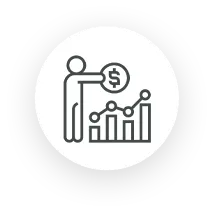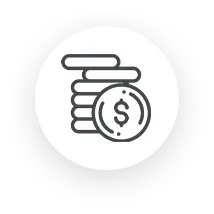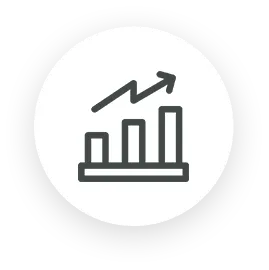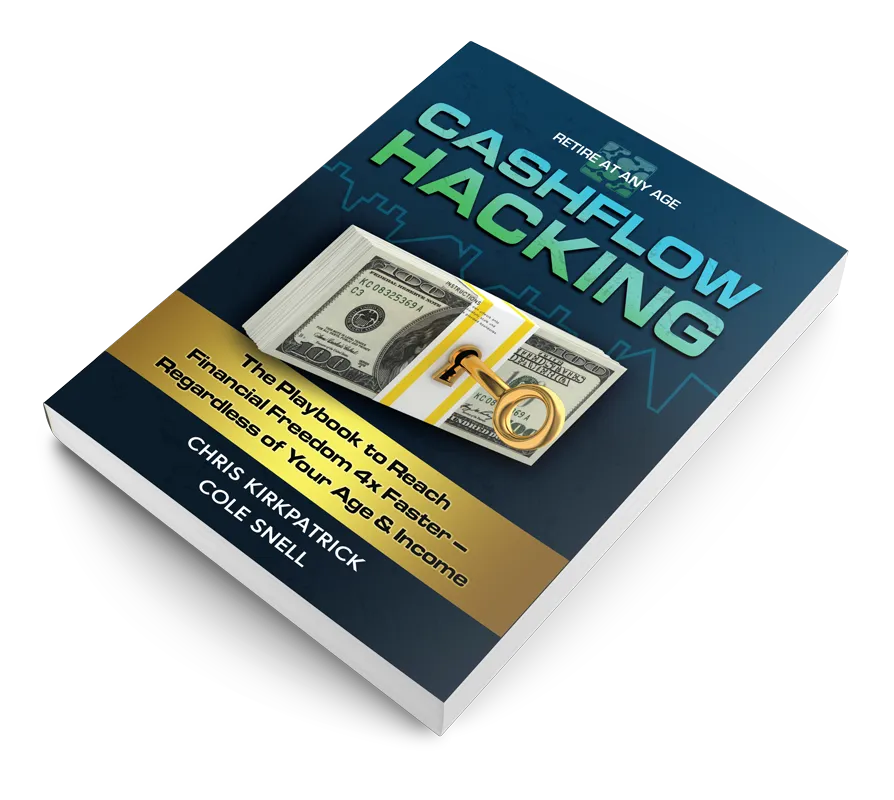
Simplifying Financial Confusion
LEARN CASH FLOW HACKING TO REACH FINANCIAL FREEDOM
Used by 90% of millionaires to reach their financial goals 4x faster

Achieve Financial Freedom Through Cash Flow Hacking

Increase Your Lifestyle While You Build Your Wealth

Position Yourself to Thrive in Market Downturn
YOU SHOULD NOT FEEL OUT OF CONTROL ABOUT YOUR FINANCIAL STRATEGY

Have easy access to your money in case of emergencies and opportunities

Use the investment strategy 90% of millionaires use

You deserve a clear plan to consistently grow your money and avoid market uncertainty

Have a guide and advisor that has your best interest in mind

Do not overpay in taxes

Stop guessing at the best vehicles to protect and grow your money

Unveiling the Biggest Deception in Personal Finance
This article is an adapted transcript of the video you can find on our YouTube channel, LIFE180.
You want to know the number one thing I wish financial advisors would stop lying about? It's the average rate of return. Unfortunately, most advisors in this country are encouraging people to start working, invest in their 401(k), and buy and hold.
They claim that if you just do that and ride the ups and downs of the market, it will average out over time. By the time you hit retirement, you'll supposedly have enough money and be good to go because it will all balance out over the long run.
In this article, I want to explain why that belief is a myth. I'll discuss why it's a myth, how it's a myth, and how it became the standard approach that advisors use to teach people how to handle their personal finances.
My promise to you is that by the time you finish this article, you'll have the facts you need to make better, more informed decisions about your personal finances. This content aims to simplify financial confusion so you can manage your money better, reach your goals with less risk, and take more accountability for the results in your life.
Wall Street Is A Value Extraction Machine
If you're here reading this, you're already aware of my perspective on the stock market and the misrepresentation of returns. As Garrett Gunderson puts it, Wall Street is not a value creation machine; it's a value extraction machine.
Somehow, the world has been convinced to go to work, get a job, save money in our 401(k)s, and relinquish control of the money we've worked so hard for. We hand it over to others who will charge us fees and extract as much value as possible, all while telling us we're too ignorant to manage our own financial results. I'm here to tell you that nothing could be further from the truth.
As I mentioned, the purpose of this material is to teach people how to take control of their financial results. I encourage you to dig deeper, whether it's through this content or elsewhere. Always challenge the status quo.
In this article, we'll be examining spreadsheets that details all the returns from as far back as 1929. My goal is to break down why people believe that buying and holding investments in the stock market, with an average return of 8%, will get them where they want to go.
Unfortunately, following this advice often leads to disappointment. As we delve into these numbers, you'll gain greater clarity on what steps you need to take to achieve the results you desire.
Average vs Actual Rate of Return
Before we dive in, let's first clarify the difference between the average rate of return and the actual rate of return. I’ll start by explaining this simple concept briefly, so you’ll have a clear understanding before we proceed.
Imagine you invested $1,000, and then the market dropped by 50%. At the end of that year, you'd have $500 left. This represents the outcome for the first year.
In the second year, feeling a bit disheartened but hopeful, you start with $500. Fortunately, the market performs exceptionally well, and it increases by 100%. So, your $500 grows by another $500, bringing your total to $1,000. Despite losing 50% in the first year and gaining 100% in the second, you end up with the same $1,000 you started with.
When I ask most people about the average rate of return after ending with $1,000 in both year one and year two, they often say 0%. However, the reality is different. With a +100% return in the second year and a -50% return in the first year, the average return is calculated as follows: (100% - 50%) / 2 years = 25%. This represents the average return over the two years.
This is why I often say that math and money are different. The discrepancy between the average rate of return and the actual rate of return illustrates why these two concepts don't always align.
While the example I used is quite extreme, it serves to illustrate a key principle: the actual rate of return is crucial when considering the long-term effects of buying and holding assets. Understanding this principle helps clarify why average rates of return can be misleading in financial planning.
A Historical Look At Market Performance

(You can view the complete spreadsheet by accessing the following
What I did there was create a spreadsheet that chronicles the history of the stock market. This spreadsheet is organized into various stages, allowing me to break down the market's evolution into distinct phases.
My goal is to provide a clear understanding of why individuals hold certain beliefs about the market. I strongly believe in examining the underlying reasons behind people's beliefs, as it helps to uncover the rationale and motivations driving their perspectives.
When you consult a financial advisor and they suggest a strategy of simply buying and holding investments to average a 7.1% return over a long period, they are illustrating how, despite market fluctuations, you can accumulate significant wealth. For example, if you hold onto an investment and it averages a 7.1% return, you'll see in the highlighted column that over time, this average return can grow to $589,000. This demonstrates the power of compounding interest.

(You can view the complete spreadsheet by accessing the following
The issue arises when negative years come into play. As demonstrated in the first example, an average return doesn’t always reflect the real-world performance of your investments. This highlights a crucial distinction between theoretical averages and actual financial outcomes. Even with an average return, the reality of how money works can differ significantly due to the impact of negative performance periods.
In this scenario, while the expectation might be $589,000, the reality is quite different. For instance, if you had invested $1,000 in 1929, you would end up with only $110,000, not $589,000. The situation worsens further when accounting for managed money fees and investment costs, which significantly reduce the final amount.
However, that’s not the focus of this article. The aim here is to explore why advisors hold these beliefs and how we can gain the necessary insights to make better decisions. To address this, I decided to break down the situation into phases. This approach helps us understand the traditional retirement mindset, which typically involves going to school, securing a job, and investing in a 401(k). Let's delve into this.
From 1929 to 1979, the average rate of return in the stock market was just 4.51%. That’s not very impressive, especially considering it spans a 50-year period. Throughout these decades, we witnessed major fluctuations, huge negative years, as well as substantial positive ones.
This period covers significant events like the Great Depression and multiple wars. There were some remarkable gains too, like a 43.96% increase in one year, which is a massive return. In fact, we probably haven’t seen a year like that since. Even 1975 had a monster year with a 38% return. But despite all these extremes, the average rate of return was still only 4.51%.
The Reason Financial Advisors Teach The 8% Return Expectation
It’s important to remember that our entire financial system today is largely built on developments that took off around 1980. That’s when 401(k) plans became popular, mutual funds gained widespread acceptance as an investment vehicle, and people began pouring money into the stock market through these qualified plans.
During this period, every Main Street investor became actively involved in the stock market, an unprecedented shift. Naturally, as stock prices and valuations are driven by the amount of money in the market and trading activities, this influx pushed asset prices higher.
From 1980 to 1999, the average return was 15.4%. This is why many people consider an 8% return to be a solid expectation, because in the early '90s, financial planning was in its heyday. The market was thriving, fee-based management was becoming more common, and major wirehouse firms were growing in popularity.
The boom in investing really took off in the 1980s, making it a mainstream activity. This momentum carried into the 1990s, leading to continued growth until the dot-com bubble burst. To fully grasp this, let’s break it down into key phases. The first phase covers the initial 50 years, where the average return was just 4.51%.
The next phase saw an impressive 15.4% average return, which is undeniably remarkable. If you were invested in the market during this period, you were a winner. This success is why our parents, I'm 43 years old, strongly believe that the best thing to do with your money is to invest it in the stock market. It worked for them, so they assume it will work for us too. But just because it worked for them doesn't mean it will work for you. It certainly didn't work for the generations before them.
And it hasn't worked as well for people since. From 2000 to 2022, the average rate of return was just 5.81%. Once again, the actual rate of return is even lower than the average when you break down the real return on money, based on what we're discussing here. Because when you throw negative years into the equation, averages go out the window.
When You Remove 1980-1999, Your Expectations Shift Drastically
So, when we examine these figures, a 4.51% average return, followed by a 15.4% surge, and then a 5.81% return, it becomes clear that the dramatic rise in returns during the 1980s and 1990s can be attributed to unique factors. The introduction of 401(k)s, qualified accounts, and the influx of investment capital created a perfect storm that drove prices up significantly. It would be interesting to analyze how returns might look if we excluded this anomaly period, as it greatly skewed the overall averages.
If you exclude that anomaly period, the actual average rate of return in the markets is much lower than people might expect. This realization can be quite startling and prompts a critical question: why do so many people continue to believe in and rely on these historical averages for their investment strategies?
When people look at the numbers and hear that they should be able to average a certain return, believing that a buy-and-hold strategy will yield good results, they might invest in their 401(k) with high hopes. However, they often find that their investments aren’t growing as quickly as expected.
This discrepancy arises because the market doesn’t always perform as anticipated over the long term. The anomaly period that showed exceptional returns has led many to believe that this is the norm, but just because it worked for previous generations doesn't guarantee it will work for us now or in the future.
When examining the current economic landscape, including global economic pressures, governmental issues, inflation concerns, national debt, and unfunded liabilities, we see a pattern that suggests increasing taxes may be on the horizon.
Rising taxes could pressure companies by reducing their profitability, which in turn might lead to lower stock performance and historically diminished asset prices. Additionally, high inflation further complicates the situation, making economic stability and growth more challenging.
Take Control Of Your Personal Finances
As interest rates rise, the economic environment becomes even more challenging. We’re facing a situation where things are likely to deteriorate further. Therefore, I strongly encourage people to stop relinquishing control over their financial outcomes. Take charge of your future and make informed decisions that put you in control.
Ask the critical questions you need to understand and always dig deeper into the reasons behind things. I firmly believe we can't simply accept information at face value. We must question why things are the way they are, why people hold certain beliefs, and why we're being offered specific products or strategies, myself included.
I am a strong proponent of whole life insurance and have a deep passion for real estate. My enthusiasm for integrating these two areas led me to develop a system I call "cash flow hacking," which I detailed in my book. Currently, my wife and I co-manage the Cashflow Hacking Fund, a private equity fund dedicated to investing in cash-flowing assets.
This fund caters to accredited investors seeking investments that not only generate cash flow but also align with their values and beliefs. Through this approach, we aim to provide tailored investment opportunities that reflect our commitment to both financial growth and ethical principles.
However, this approach isn't suitable for everyone. Our fund is designed for accredited investors, and it's essential that it aligns with your personal beliefs and financial goals. If my perspective doesn't resonate with you, it may be best to explore other options. Often, people aren't asking the critical questions needed to reach their own conclusions.
Instead, they may be influenced by sales pitches without fully evaluating the underlying principles. It's crucial to be a critical thinker and ensure that any investment aligns with your own values and understanding.
I urge you to embrace critical thinking and conduct thorough research on your own. Dive deep into the details, create spreadsheets, fact-check information, and analyze everything meticulously. It's important to determine what truly works for you based on your individual circumstances and objectives.
My encouragement to you is to never invest in something you don't fully understand. Always scrutinize the fine print, read between the lines, and grasp the underlying math and variables affecting your investments. Understanding how your money will behave in the future and the factors influencing it is crucial for making informed decisions.
If you don't take the time to understand your investments, it ultimately becomes a case of "buyer beware," and the responsibility falls on you for not doing your due diligence. Unfortunately, many people in our nation fail to critically examine why they are being taught certain personal finance principles and practices.
Unfortunately, I personally believe that the financial system is not designed to help you succeed. Instead, it often serves to separate you from your money, enrich Wall Street, and perpetuate a massive transfer of wealth that we have never seen before in history.
I hope this provides you with some clarity and encourages you to dig deeper into your research. If you found value in this, please share it to help others gain insight as well.
Till next time. Have a blessed inspirational day.
HOW TO START TAKING CONTROL OF YOUR FINANCES BY MAXIMIZING YOUR CASH FLOW AND PROTECTING YOUR ASSETS

1. Schedule Your Free Clarity Call

2. Create a Free Customized Plan

3. Get Guide to Financial Success
GET YOUR FREE COPY TO STOP USING OUTDATED RETIREMENT STRATEGIES
Cash Flow Hacking teaches you to:
Protect Your Investments
Thrive in bad markets
Reach financial freedom faster

ARE YOU LOOKING FOR:

Cash Flow Hacking teaches you to:
Security to protect your money
Increased cash flow and lifestyle
Inflation protection
Financial certainty in all economic environments
A reduction in taxes
Safe and fast access to your money with no penalties
WHO IS THIS PROGRAM FOR?

People looking for an alternative
Are you looking for alternatives to Wall Street’s “buy and hold” strategy that takes 40 years with uncertain results? Our Cash Flow Hacking strategies provide you the building blocks to get started on the right foot

Passionate Entrepreneurs
Are you looking for a financial strategy that will take your best assets (you and your businesses) and multiply their potential? Our Cash Flow hacking strategies will teach you how to invest for the future without sacrificing building your business

Real Estate
Investors
Are you a real estate investor who is burned out from being a landlord or playing the fix-and-flip game? Our Cash Flow Hacking strategies will provide you with the system to create predictable wealth AND give you the freedom you are looking for.
YOU DESERVE PEACE OF MIND AND A PLAN THAT WILL PROTECT YOUR FAMILY AND GROW YOUR WEALTH
Today you need to be more savvy than ever if you try to go at it alone.
Losing money to inflation, taxes, and just poor investment strategies is leaving you frustrated, feeling out of control and not knowing where to turn. To add to the problem, the market is flooded with advisors who have outdated advice that does not place your best interests first, but instead focuses on charging you a fee that creates guaranteed cash flow for them.
NOT YOU
We believe this is wrong and that your security and best interests should be placed first. We believe you should be in a position where you control your money, your money doesn't control you. We understand because we talk with hardworking people everyday that are losing money in the markets based on old information and feel like they are guessing at the best course of action.
We created the Cash Flow Hacking plan to help you have security and control of your money to take advantage of life's opportunities because you deserve peace of mind with your wealth. The old way of planning for retirement of… Go to school Get a job & save as much as you can in your 401k and mutual funds...is broken.
You have been lied to. Think about it, where else in life does someone tell you that the most certain way to achieve your desired result is to take on more risk? The math just doesn't work, and the results are showing in our country and world. Did you know that 90% of millionaires in the United States have 1 asset in common?
Hint: it's not stocks or mutual funds (and no...it's not crypto) How much sense does it make for you to work hard, save money, reduce your current lifestyle (because that's what you are doing when you save for the future - taking money you could use on lifestyle today and delaying gratification to a future unknown time), and hope that whatever you are doing will work three to four decades from now? If you're thinking, "not much sense at all…", you are in the right place.
With over 50 years of experience on our team, we have worked with thousands of individuals and families to achieve financial freedom faster and with more predictability by helping them invest for Cash Flow.
How does the Cash Flow Hacking Plan work? 1. Take the Cash Flow Hacking Challenge 2. Complete the LIFE180 X-Ray and determine what your Freedom Number is 3. Work with a Cash Flow Hacking expert to provide you a customized plan
The customized Cash Flow Hacking plan will give you clarity on where you are now, where you want to go (and in what time frame), and what you need to do to get there predictably.
We value and commit to you: We believe you deserve the best financial education and guidance We believe financial decisions should not be rushed but be well thought out with a plan We believe you should be in control of your money We believe we earn your trust through time, education, and proper due diligence Without a proper plan and guidance, your money can be lost to taxes, inflation, and bad investments You deserve more with the most up-to-date strategies to mitigate your risk, control your money, and earn stable returns regardless of the market Schedule a call here to attain your LIFE180 Financial X-Ray now or get started with the Cash Flow Hacking Challenge for free.
I am interested in...